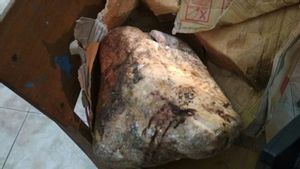JAKARTA - The charm of Ancol as a place of entertainment has been started since a long time ago, even before Indonesia's independence. Before being enjoyed by the natives, Ancol was a place where the rich Dutch spent their vacation time.
By location, Ancol is strategic. Apart from that, the calm atmosphere, plus the many luxury villas are another attraction of Ancol. In its history, the existence of the Ancol area can be seen in the ancient Sundanese manuscript of the 15th century, Carita Parahiyangan .
The text illustrates that Ancol was once touted as the location of the battlefield, beside Kalapa (Sunda Kalapa), Tanjung, Wahanten (Banten), and other places during the reign of the King of Sunda, Prabu Surawisesa (1521-1535).
Meanwhile, for the name Ancol, Rachmat Ruchiat in the book The Origin of Place Names in Jakarta (2018), tells that the name Ancol means low, swampy land. There is a reason. In the past, when the sea was high, the brackish water of Kali Ancol could turn to land to inundate the surrounding land, making it taste salty.
Therefore, the Dutch in the VOC era then called this area zoutelande or salty land. The designation is also given to the stronghold, in the form of a canal built in the Ancol area in 1656.
"Before the canal was built to connect the City of Batavia, the VOC government built the Ancol canal, which is still navigable by boats. Then, a road parallel to the canal was built. Considered strategic in the context of defense of the City of Batavia, canals, roads and canals were built in Ancol, "wrote Rachmat Ruchiat.

After Jayakarta was controlled by the Dutch trading partner, VOC in 1619, Jayakarta changed its name to Batavia. In the hands of the VOC, Ancol became a stronghold after the first attack by the Mataram Work on Batavia in 1628. We reviewed the details of the attack earlier in the writing "The Story of the Mataram Attack Company with Feces Behind the Nickname 'Batavia Kota Tahi.'" To that end, the VOC began strengthen the defense by building a number of fortresses.
Because the only remaining fortresses were Kasteel Batavia and Onrust Island, the construction of the new fort began to be overtaken by the Dutch. Some of them are Fort (fort) Jacatra, Fort Rijswijk, Fort Noordwijk, Fort Vijfhoek, Fort Angke, and Fort Antjol. The construction of this new fort made the Dutch confident against Mataram, which resulted in victory.
After that, the land around Fort Antjol was controlled by VOC officials, Jeremias van Riemsdijk, before he became Governor General of the VOC in 1775. Jeremias built a vacation home in the form of a luxury villa. Partly again, Jeremias cleared his land to make agricultural land and turned part of the swamp into productive land.
Not only that. The owner of the land also made the canal between Kasteel Batavia and Fort Antjol a traffic lane for transporting trade commodities. Jeremias also brought in slaves from various places to succeed in his efforts to form agricultural land. This effort was made to increase other coffers of income, apart from being a VOC official.
Miraculously, Jeremias' move to create a luxury villa was followed by other wealthy people, including VOC Governor General Adriaan Valckenier (1737-1741). Since then, Ancol has become a special recreation area for Dutch citizens for weekends. In time, all these things will be the basis for why Ancol is called the "dream garden".
"It seems that since three centuries ago, Ancol has become a place of recreation, especially for Dutch citizens for the weekend. Seen a number of Dutch noni-noni with the umbrella of their slaves enjoying Ancol beach. Some of them use telescopes, ”wrote Alwi Shahab in the book Time of the Netherlands, Drunk was Born in Batavia (2013).
It was forgotten and became a monkey's den

The story of Ancol as a place of recreation was also recorded by VOC Artillery Officer, Johannes Rach (1720-1783) in a painting depicting the condition of Ancol Beach in 1772. At that time the area was called Slingerland. However, the glory of Slingerland as a place of leisure must come to an end. The large number of epidemics that have infected Batavia residents is the main cause.
As a result, during the reign of the Governor General of the Dutch East Indies, Herman Willem Daendels (1808–1811) all buildings including the Batavia Castle and a line of luxury Ancol villas in Oud Batavia (Old Batavia) were destroyed. With the remaining ruins, Daendels established and moved the center of government from Oud Batavia (Old Batavia) to Nieuw Batavia (New Batavia) in Weltevreden, or what was known as the area around the Banteng field. As a result, Ancol has become a forgotten area for quite a long time.
Long uninhabited, the Ancol area became a thicket forest. This condition lasted until entering the 1950s. Because there is no life, Ancol is known as a monkey's den. Therefore, when vehicles start to cross the Ancol bridge, they must be extra careful. Not because there is a ghost from Ancol bridge, but because the monkeys often run out of the forest.
Even so, Ancol is still visited for leisure, although it is not as busy as before. One of the people who had experienced the pleasure of traveling to Ancol in the 1950s was Firman Lubis. Through his book, Jakarta 1950-1970 (2018), Firman wrote about his experience of going on a trip to Ancol with friends for fishing. Firman said, Ancol was once overgrown with shrubs, mangroves, coconut trees, and hundreds of palm trees.
It is said that because Ancol is lonely, rumors of crocodiles still living in the Ancol swamps in the early 1950s were quite popular among the residents of the capital. However, the ruler of this area is not the crocodile. This is because the monkeys, which are very numerous, seem to have transformed into Ancol rulers.
"Around the railroad track at the end of Jalan Gunung Sahari opposite the entrance to Taman Ria Ancol now, many monkeys roam freely. Known as the Ancol monkey, it belongs to a species called Macacus. The monkeys often cluster around the train tracks at the T-junction at the end of Jalan Gunung Sahari and Jalan Ancol. "
Firman also added that those who travel to Ancol often pay attention to the behavior of monkeys. Some gave peanuts, and some provided other food to entertain themselves and see the behavior of the Ancol monkeys.
"At that time, the Ancol monkey was quite well-known among the citizens of Jakarta, so people in Jakarta used to curse someone they did not like or considered behaving strangely by saying: you Ancol monkey!" close the Word.
The English, Chinese, Japanese, Arabic, and French versions are automatically generated by the AI. So there may still be inaccuracies in translating, please always see Indonesian as our main language. (system supported by DigitalSiber.id)











